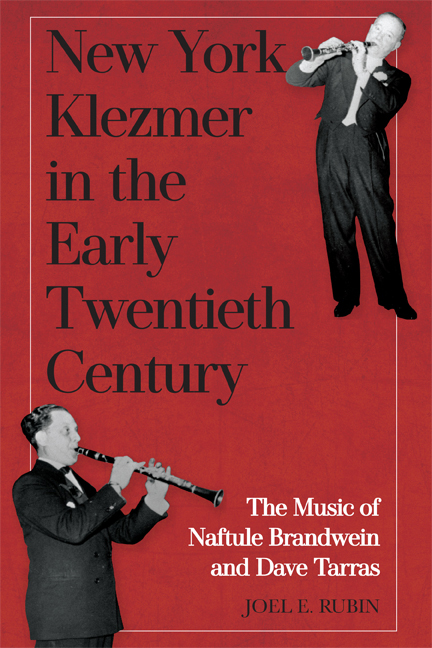Book contents
- Frontmatter
- Contents
- Acknowledgments
- List of Abbreviations
- Note on Orthography and Transliteration
- About the Companion Website
- Introduction: “If You Called Me A Klezmer Thirty-Five Years Ago …”
- 1 A Wedding in Town Was Like a Holiday: A Short History of Klezmorim in Europe
- 2 Klezmer in New York: Changing Meanings, Changing Contexts
- 3 A Kind of “Ethnomusicological Archive”: Commercial 78-rpm Recordings of Klezmer Music
- 4 A Single Field Irrespective of Origin: Polymusicality and Language, Aesthetics, Classification, and Transcription
- 5 “What Mattered Was What’s Happening with the Tune”: Modality and Compositional Processes
- 6 “The Little Things That They Do”: Ornaments and Performance Practice Techniques
- 7 “The Newest Bulgar Out That Everyone Played”: New York Klezmer after 1929
- Glossary
- Notes
- Bibliography
- Index
4 - A Single Field Irrespective of Origin: Polymusicality and Language, Aesthetics, Classification, and Transcription
Published online by Cambridge University Press: 11 September 2020
- Frontmatter
- Contents
- Acknowledgments
- List of Abbreviations
- Note on Orthography and Transliteration
- About the Companion Website
- Introduction: “If You Called Me A Klezmer Thirty-Five Years Ago …”
- 1 A Wedding in Town Was Like a Holiday: A Short History of Klezmorim in Europe
- 2 Klezmer in New York: Changing Meanings, Changing Contexts
- 3 A Kind of “Ethnomusicological Archive”: Commercial 78-rpm Recordings of Klezmer Music
- 4 A Single Field Irrespective of Origin: Polymusicality and Language, Aesthetics, Classification, and Transcription
- 5 “What Mattered Was What’s Happening with the Tune”: Modality and Compositional Processes
- 6 “The Little Things That They Do”: Ornaments and Performance Practice Techniques
- 7 “The Newest Bulgar Out That Everyone Played”: New York Klezmer after 1929
- Glossary
- Notes
- Bibliography
- Index
Summary
Harshav's Polylingualism as a Model for the Musical Language of the Klezmorim
In order to understand better the musical processes taking place in klezmer music, it is useful to draw comparisons to a model for the Yiddish language developed by Benjamin Harshav. He makes three major points:
1. Yiddish was spoken by people in a bilingual (or multilingual) context.
2. Yiddish is a fusion of elements from several source languages that are still used as living components of an open language field.
3. Yiddish was the carrier of a second level of social language, a peculiar semiotics of Jewish communication.
A major characteristic of Yiddish as it developed in eastern Europe was that its “polylingualism” consisted of two kinds, “internal” and “external.” Internally, the Jewish communities utilized three languages: Yiddish, Hebrew, and Aramaic, all written in the same alphabet. Students learned the Hebrew text of the Bible in kheyder (religious primary school) by translating it word by word into Yiddish. In addition, Talmudic learning in Aramaic and Hebrew was “reunderstood, rephrased, explained, juxtaposed, challenged, and argued in Yiddish dialogues, lectures and sermons. Yiddish provided the syntactical frame for each sentence and the dialogical framework for the discourse as a whole; it served as the conversational setting in which all those treasures … were embedded.” Harshav's theory is that Yiddish and loshn-koydesh were “interlaced in one polysystem” in which “Yiddish served primarily as the oral vehicle of communication with Hebrew and Aramaic supplying and multiplying the library of texts.” He writes, “The same Yiddish language, with the same grammatical structure and basic vocabulary, served the mundane purposes of the same people in their family lives; there was a direct flow of expressions and discourse patterns and gestures between the two domains of life, study and home.”
It could be said that in a similar fashion, the Yiddish-speaking Jews of eastern Europe were “polymusical,” exhibiting characteristics of internal and external polymusicality. The internal musical languages of the klezmorim— secular folk song, badkhones and the music of the purim-shpil (representing Yiddish), and those of the various types of synagogue chants and religious folk songs (representing Hebrew-Aramaic)—were also interlaced in a kind of musical polysystem with which most Yiddish-speaking Jews were familiar. Max Wohlberg has shown, for example, the influence of eastern Ashkenazic liturgical music on Yiddish folk song.
- Type
- Chapter
- Information
- New York Klezmer in the Early Twentieth CenturyThe Music of Naftule Brandwein and Dave Tarras, pp. 102 - 121Publisher: Boydell & BrewerPrint publication year: 2020

